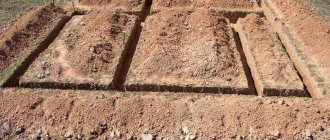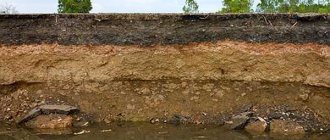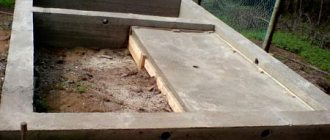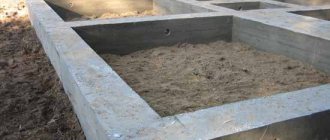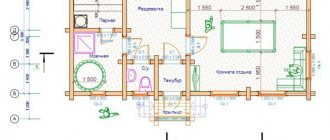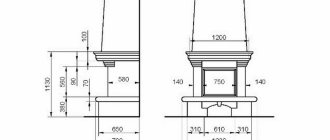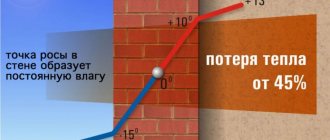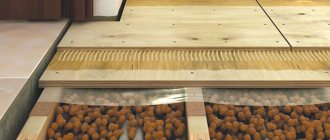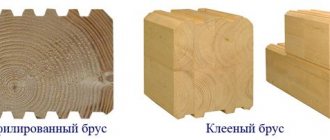Soil freezing depth (df) is a standard value that shows the level of freezing of the soil horizon in winter and is determined on the basis of long-term observations in each region of Russia. The lower limit of this zone is called soil freezing point.
The GPG value is one of the most important parameters when determining the depth of the foundation, which means finding this coefficient is mandatory for any construction. Knowing the depth of freezing allows you to protect the foundation, since in winter the stress in the soil is redistributed, groundwater passes from a liquid state into ice, its volume increases to 10-15% and heaving processes begin.
If the base of the foundation is not deep enough, then colossal vertical pressure will be exerted on the walls, which will certainly lead to deformations and disruption of the integrity of the foundation. If the base of the foundation is located below the level of the HGG, then the forces of frost heaving will act on the side walls tangentially , that is, the foundation will be pushed out in winter, and sink back in in summer.
Calculation of soil freezing depth
Until recently, calculating the depth of soil freezing was carried out manually using SNiP and other regulatory documents - this is not very convenient, since you have to scroll through more pages to find the region/city you need. We suggest using our online calculator, which allows you to determine the standard and estimated depth of soil freezing in ONE CLICK - you need to select a locality and click the “ Calculate ” button. The database of our program is based on information from SNiP 23-01-99 (SP 131.13330.2012 “Building climatology”).
Our tool contains information on all regions and cities of Russia, including: Moscow region, Leningrad region, Nizhny Novgorod, Sverdlovsk, Rostov, Samara, Chelyabinsk, Kaliningrad regions, Perm, Khabarovsk, Primorsky Territories, Bashkortostan, Tatarstan, Crimea.
The influence of frost heaving of soil
The term “frost heaving” refers to the level of soil deformation during thawing or freezing. It depends on how much liquid is contained in the soil layers. The higher this indicator, the more the soil freezes, since according to physical laws, when freezing, water molecules increase in volume.
The power of frost heaving
Another factor influencing frost heaving is the climatic conditions of the region. The more months with sub-zero temperatures, the more the ground freezes.
Silty and clayey soils are most susceptible to frost heaving; they can increase in size by 10% of their original volume. Sands are less susceptible to heaving; rocky and rocky sands do not have this property at all.
The depth of ground freezing specified in SNiP was calculated taking into account the worst climatic conditions in which snow does not fall. The actual level to which the ground freezes is less, since snowdrifts and ice act as heat insulators.
The ground under the foundations of buildings freezes less, since in winter it is additionally warmed by heating.
The impact of soil heaving on a slab foundation
To protect the soil from freezing, you can additionally insulate the area at a distance of 1.5–2.5 meters around the perimeter of the base of the house. This way you can arrange a shallow strip foundation, which is also more economical.
Soil freezing depth by region of Russia (map + table)
| City | Soil freezing depth, cm |
| Arkhangelsk | 175 |
| Vladivostok | 180 |
| Vologda | 170 |
| Ekaterinburg | 190 |
| Irkutsk | 190 |
| Kazan | 175 |
| Kaliningrad | 80 |
| Krasnoyarsk | 200 |
| Kursk | 130 |
| Moscow | 130 |
| Nizhny Novgorod | 155 |
| Novosibirsk | 220 |
| Omsk | 220 |
| Eagle | 130 |
| Permian | 190 |
| Pskov | 120 |
| Rostov-on-Don | 90 |
| Ryazan | 130 |
| Samara | 165 |
| Saint Petersburg | 120 |
| Saratov | 145 |
| Simferopol | 70 |
| Surgut | 270 |
| Tyumen | 210 |
| Khabarovsk | 190 |
| Chelyabinsk | 215 |
| Yakutsk | 240 |
| Yaroslavl | 170 |
5.4. FOUNDATION DEPTH (Part 2)
dfn values
> 2.5 m are observed mainly in the regions of Eastern and Western Siberia. Formula (5.25) and the map are not recommended for use in mountainous areas, where the actual freezing depth is greater due to the composition and properties of soils, terrain and climate. Under these conditions, the standard freezing depth should be determined by thermal engineering calculations []:
,
(5.26)
where λ f
— thermal conductivity of frozen soil, W/(m×°C);
Tout,n
is the absolute value of the average air temperature for the period of negative temperatures, °C:
Tout,n
= ∑
|Tf|
/
n
(here
n
is the number of months with a negative average monthly temperature);
Tb,f
- temperature of the beginning of soil freezing, °C:
tn,p
- duration of the period with negative air temperatures, corresponding to
n
-1 months, s;
L
0 - specific heat of the water-ice phase transformation, taken equal to 3.35 × 108 J/t;
ω tot
—total natural soil moisture, fractions of a unit;
ωω is the relative (by mass) content of unfrozen water, fractions of a unit, at a temperature equal to 0.5( Tout,n + Tb,f
);
ρdf
—density of frozen soil in a dry state, t/m3;
Cf
is the volumetric heat capacity of frozen soil, J/(m×°C).
Rice. 5.16. Schematic map of standard freezing depths for loams in the Primorsky and Khabarovsk territories, as well as in the Amur region.
1—southern border of permafrost or border of island permafrost; 2 - points with permafrost
Example 5.4.
Determine the standard depth of soil freezing in the city of Achinsk, Krasnoyarsk Territory.
The site is composed of loam with the following characteristics: fluidity index IL
= 0.64, density ρ = 1.8 t/m3, density of frozen soil in a dry state ρ
df
= 1.4 t/m3, total humidity ω
tot
= 0.25, humidity at the rolling boundary ω
p
= 0.16, relative content of unfrozen water ωω = 0.08, humidity at the yield boundary ω
L
= 0.30, plasticity number
Ip
= 0.14.
Other quantities included in formula (5.26): Tout,n
= 13.2 °C;
Тb,f
= 0.2 °С;
tn,p
= 6 × 30 × 24 × 3600 = 15.55 × 106 s;
λ f
= 1.513 W/(m × °C);
Cf
= 2.053 × 106 J/(m3 × °C);
∑ |Tf|
= 69.1 °C.
Solution.
The standard freezing depth of soil is:
according to formula (5.25)
m;
according to formula (5.26)
m,
which differs significantly from the result obtained using formula (5.25). In this case, when assigning the depth of foundations, dfn
= 2.6 m.
The estimated depth of seasonal soil freezing is determined by the formula
df = khdfn
,
(5.27)
where kh
- coefficient taking into account the influence of the thermal regime of the structure and accepted: for external foundations of heated buildings - according to table.
5.9; for external and internal foundations of unheated buildings kh
= 1.1, except for areas with negative average annual temperatures.
TABLE 5.9. COEFFICIENT VALUE kh
| Features of the structure | kh at the estimated average daily air temperature in the room adjacent to the external foundations, °C | ||||
| 0 | 15 | 10 | 15 | 20 or more | |
| Without a basement with floors arranged: on the ground on joists on the ground on an insulated basement floor | 0,9 1,0 1,0 | 0,8 0,9 1,0 | 0,7 0,8 0,9 | 0,6 0,7 0,8 | 0,5 0,6 0,7 |
| With a basement or technical underground | 0,8 | 0,7 | 0,6 | 0,5 | 0,4 |
Notes: 1. Values of the coefficient kh
refer to foundations whose base extends from the outer edge of the wall to less than 0.5 m;
with a console length of 1.5 m or more, the values of the kh
increase by 0.1, but not more than 1;
for intermediate values of the cantilever length, the coefficient kh
is determined by interpolation.
2. The premises adjacent to the external foundations include basements and technical undergrounds, and in their absence, the premises of the 1st floor.
3. At intermediate values of air temperature, coefficient kh
accepted by rounding to the nearest lower value indicated in the table.
In areas with negative average annual temperatures, the estimated depth of soil freezing for unheated structures should be determined by thermal engineering calculations in accordance with the requirements of SNiP []. Similarly, the df
is determined in the case of using permanent thermal protection of the base, as well as if the thermal regime of the designed structure can significantly influence the temperature of the soil (refrigerators, greenhouses, boiler rooms, hot shops, etc.).
An increase in the depth of soil freezing under the foundations of unheated structures is associated with worse soil thawing conditions in the summer under these structures than in open areas.
The depth of laying the foundations of heated structures, according to the conditions for eliminating frost heaving of the foundation soils, should be assigned:
- – for external walls and columns - according to the conditions set out in table. 5.10; the depth of laying external foundations can be set regardless of the calculated depth of soil freezing, if the foundations rest on fine sand and special studies on this site have established that they do not have heaving properties, as well as in cases where studies and calculations have established that the deformation of foundation soils during their freezing and thawing do not affect the serviceability of the structure;
- – for internal walls and columns - regardless of the calculated depth of soil freezing.
For external and internal foundations of heated structures with cold basements and technical undergrounds (having negative temperatures in winter), the laying depth should be taken according to table. 5.10, counting from the floor of the basement or technical underground.
The depth of laying external and internal foundations of unheated structures should be assigned according to table. 5.10, the depth is calculated in the absence of a basement or technical underground from the planning level, and if they are present - from the floor of the basement or technical underground.
TABLE 5.10. DEPTH OF LAYING FOUNDATIONS ACCORDING TO THE CONDITIONS OF FROST HEAVING OF FOUNDATION SOILS
| Soils located under the base of the foundation | Depth of foundations at the depth of the groundwater level, m | |
| dw ≤ df + 2 | dw > df + 2 | |
| Rocky, coarse-grained with sand filler, gravelly sands, large and medium-sized | Does not depend on df | Does not depend on df |
| The sands are fine and dusty | Not less than df | Same |
| Sandy loam with fluidity index: IL < 0 IL ≥ 0 | Same – || – | – || – Not less than df |
| Clay loams, coarse soils with silty clay filler with soil or filler fluidity index: IL ≥ 0.25 IL < 0.25 | – || – – || – | The same Not less than 0.5 df |
Notes: 1. The depth of foundations can be taken regardless of the calculated freezing depth df
, if the corresponding soils indicated in this table lie to a depth of at least the standard freezing depth
df
.
2. The position of the level of groundwater and high water must be taken into account their possible changes during the construction and operation of the structure.
The design of foundations and foundations must include measures to prevent the foundation soils from being moistened, as well as from freezing during the construction period.
The depth of foundations under frost heaving conditions can be reduced through the use of: constant thermal protection of the soil along the perimeter of the structure; water protection measures that reduce the degree of soil heaving; complete or partial replacement of heaving soil with non-heaving soil under the base of the foundations; coating the side surface of foundations, reducing the freezing of soil with it; soil salinization, etc. The feasibility of using certain measures must be technically and economically justified. In addition, the depth of foundations can be reduced through the use of structural measures that ensure the strength and normal operating conditions of the structure in case of uneven deformations of the foundations due to the freezing and thawing of heaving soils.
To protect the foundation soils from moisture, the site under construction for each structure, before the construction of the foundations, must be fenced with upland ditches and carefully planned with the installation of surface drains (ditches and trays), and, if necessary, drains.
The method of protecting foundation soils from freezing is adopted depending on the type and condition of the soil, the position of the groundwater level, the design features of the underground part of the structure and local construction conditions (climatic, industrial, etc.).
The type of soil used for backfilling the sinuses of pits, the method and degree of its compaction should be determined based on the condition that during construction and operation the tangential forces of frost heaving do not exceed the forces that keep the foundation from heaving []. If necessary, measures must be taken to reduce the tangential forces of heaving (coating foundations with special compounds, salinizing backfill soils with substances that do not cause corrosion of concrete and reinforcement, etc.).
Guidelines for the design of foundations and foundations on heaving soils
Guidelines for the design of foundations of buildings and structures
SNiP 2.02.01-83 Foundations of buildings and structures
SNiP 2.02.04-88 Foundations and foundations on permafrost soils
Soil freezing depth in the Moscow region
| City | Soil freezing depth, cm |
| Moscow | 130 |
| Balashikha | 125 |
| Podolsk | 130 |
| Kolomna | 115 |
| Serpukhov | 120 |
| Orekhovo-Zuevo | 125 |
| Sergiev Posad | 130 |
| Zelenograd | 130 |
| Solnechnogorsk | 125 |
Notes from the designer
Let's consider the method for calculating the seasonal depth of soil freezing.
1.Initial data
The calculation is made in accordance with:
SP 22.13330.2011 Foundations of buildings and structures
SP 131.13330.2012 Construction climatology
Thermal mode influence coefficient kh: 1.1
For the locality of Moscow, according to SP 131.13330.2012 Table 5, months with negative average monthly temperatures are presented below:
January t1=-7.8°C
February t2=-7.1°C
March t3=-1.3°C
November t11=-1.1°C
December t12=-5.6°C
2.Calculation
Let us determine the value of the Mt-dimensionless coefficient, numerically equal to the sum of the absolute values of average monthly negative temperatures in accordance with clause 5.5.3 of SP 22.13330.2011.
Mt=(7.8+7.1+1.3+1.1+5.6)=22.9
Type of soil: Sandy loam, fine and dusty sands
Then we determine the value of the standard depth of seasonal soil freezing using the formula (5.3 SP 22.13330.2011) dfn=d0(Mt)0.5
where d0 is the value accepted for the type of soil - sandy loam, fine and silty sands equal to 0.28 m in accordance with the instructions of clause 5.5.3 of SP 22.13330.2011.
Then
dfn=0.28(22.9)0.5=1.34m
The estimated depth of soil freezing will be determined using the formula (5.4 SP 22.13330.2011)
df=dfnkh=1.34·1.1=1.47m
Soil type: Loams and clays
Then we determine the value of the standard depth of seasonal soil freezing using the formula (5.3 SP 22.13330.2011) dfn=d0(Mt)0.5
where d0 is the value accepted for the type of soil - loam and clay equal to 0.23 m in accordance with the instructions of clause 5.5.3 of SP 22.13330.2011.
Then
dfn=0.23(22.9)0.5=1.1m
The estimated depth of soil freezing will be determined using the formula (5.4 SP 22.13330.2011)
df=dfnkh=1.1·1.1=1.21m
Type of soil: Gravelly sands, coarse and medium coarse
Then we determine the value of the standard depth of seasonal soil freezing using the formula (5.3 SP 22.13330.2011) dfn=d0(Mt)0.5
where d0 is the value accepted for the type of soil - gravelly, coarse and medium-sized sands equal to 0.3 m in accordance with the instructions of clause 5.5.3 of SP 22.13330.2011.
Then
dfn=0.3(22.9)0.5=1.44m
The estimated depth of soil freezing will be determined using the formula (5.4 SP 22.13330.2011)
df=dfnkh=1.44·1.1=1.58m
Soil type: Coarse soils
Then we determine the value of the standard depth of seasonal soil freezing using the formula (5.3 SP 22.13330.2011) dfn=d0(Mt)0.5
where d0 is the value accepted for the type of soil - coarse clastic soils equal to 0.34 m in accordance with the instructions of clause 5.5.3 of SP 22.13330.2011.
Then
dfn=0.34(22.9)0.5=1.63m
The estimated depth of soil freezing will be determined using the formula (5.4 SP 22.13330.2011)
df=dfnkh=1.63·1.1=1.79m
A table of freezing depths for different types of soil by region and locality in Russia can be found here.
Soil freezing depth in the Leningrad region
| City | Soil freezing depth, cm |
| Saint Petersburg | 120 |
| Gatchina | 120 |
| Vyborg | 125 |
| Pinery | 120 |
| Kingisepp | 120 |
| Meadows | 115 |
| Volkhov | 120 |
| Tikhvin | 120 |
| Sviritsa | 125 |
Effect of snow cover thickness
According to SNiP, the value of freezing depth also depends on the thickness of the snow layer that lies on a given soil in winter. The graph of this dependence is well illustrated in the graph below.
Graph of soil freezing versus snow cover thickness
This circumstance goes logically contrary to the generally accepted procedure for clearing the area around the house from snowdrifts. People, trying to restore order, without realizing it, create a zone of uneven soil freezing on their site. This can damage the foundation, the ground under which can freeze very much and begin to deform the foundation.
With additional insulation of a shallow strip foundation, it is not afraid of frost deformations
In order to create additional insulation of the foundation, as a tip, it will help to plant a low shrub around the perimeter of the house, which will be able to collect snow and protect your foundation from the cold.
3.7 / 5 ( 4 voices)
At what speed does freezing occur?
The values of negative air temperatures are perhaps the main factor determining the speed at which the soil will freeze under certain conditions. Many experiments have been carried out that have confirmed that the amount of swelling is greater if the freezing rate is lower. There is a dependence of these indicators in the opposite direction.
The filtration coefficient of clay soil can also influence the amount of soil swelling. This determines how much moisture penetrates the frost line.
When the freezing rate is quite low, an icy texture is formed. And this process is accompanied by an increase in the number of ice inclusions. This is due to the fact that water rises up from the lower layers. When these types of soil thaw, their physical properties deteriorate. In some cases, if before freezing the soil had a plastic or solid state, then after thawing and freezing the state may become current.
When the soil freezes to a depth of 1–1.2 meters, the largest values in the amount of ice add up. In any case, if the soil itself is of natural composition. This occurs where fluctuations in negative temperatures are greatest. This usually happens when the weather changes, there is a thaw, and so on.
Getting rid of capillary water and cracks in the basement
So, how to remove dampness in the basement as a result of detecting cracks:
- To do this, you should carefully check all surfaces for the presence of small and large cracks. It may be necessary to partially or completely dismantle the thermal insulation coating of the ceiling and walls, as well as remove the floor covering.
- It is necessary to carefully seal the place of integrity violation after its discovery.
- Next you need to carry out waterproofing work. These works are divided into external and internal.
External waterproofing
- Slopes on the roof, above the porch and on the windows;
- “Directed action” drainpipes, that is, those that drain water directly into an underground storm drain funnel or at least into an above-ground gutter;
- Drainage system located around the walls of the building;
- Blind area.
To do this you need:
- Remove the old blind area;
- Dig a hole outside the outer walls of the basement, the width of which will be a little more than half a meter. This is done so that there is an opportunity to get down into this pit and carry out work;
- Thoroughly dry the outer wall of the building (forced or natural);
- Coat the wall with special antifungal compounds (there is a huge selection of such compounds in hardware stores);
- Coat the wall with bitumen mastic (you can also use concrete with additives that reduce moisture absorption, either based on liquid glass or ordinary clay);
- The last, sixth stage is optional. You can make an underground blind area from a sheet of roofing felt. Especially for this, you need to fix a sheet of roofing material 0.5 meters above the ground level on the wall of the building and take it beyond the edge of the outer wall.
- Next you need to fill the hole.
- The blind area needs to be equipped (it is possible to use any type of soft roof for this).
Attention: If a person is unable to carry out serious excavation work, it is possible to get by with only the last point for the first time. And the sheet of soft roofing will have to partially extend onto the wall of the building (about fifty to seventy centimeters).
Internal basement waterproofing
To get rid of dampness in the basement, you need to:
- First, you should thoroughly dry the entire room;
- Get rid of those coatings that are crumbling;
- Clean out all cracks;
- Seal each crack with cement mortar;
- Impregnate the walls of the room with an antifungal drug;
- Coat everything with a waterproofing solution (the simplest is bitumen mastic);
- It will be necessary to carefully seal pressure leaks and all their former locations. For example, alabaster.
Attention: To enhance the effect, it is possible to completely plaster the walls of this room or only partially, 0.5-1 meter from the floor
In order to correct this situation, you need to remove the decorative flooring, sealing all the cracks in the concrete, if any. Then wait for everything to dry and cover it with expanded clay or sand - there should be about a five-centimeter layer. Next, you need to lay roofing felt or other high-strength waterproof material. After treatment with bitumen mastic has been carried out, it is possible to make a new screed or lay logs and lay a plank floor on them.
Types of “anti-heaving” foundations and measures.
The degree of manifestation of frost heaving must be taken into account when choosing the type of foundation. “Anti-heaving” options are foundations using TISE technology, screw piles, buried strips with a monolithic wide cushion (with a cushion, because without it, light houses on a strip are also susceptible to heaving), a monolithic slab located below the soil freezing line.
Of course, the widening of TISE piles, the blades of screw piles and the monolithic half of the buried tape must be located below the freezing line to give them the function of an “anchor”. Anti-heaving types of foundations do not include columnar foundations without widening, shallow-buried strips, floating slabs, as well as straight buried strip foundations without a wide monolithic cushion (in practice, our company knows many cases when the walls of a buried strip are compressed by swelling soil so strongly that the soil follows drags the foundation along with the house along with it).
